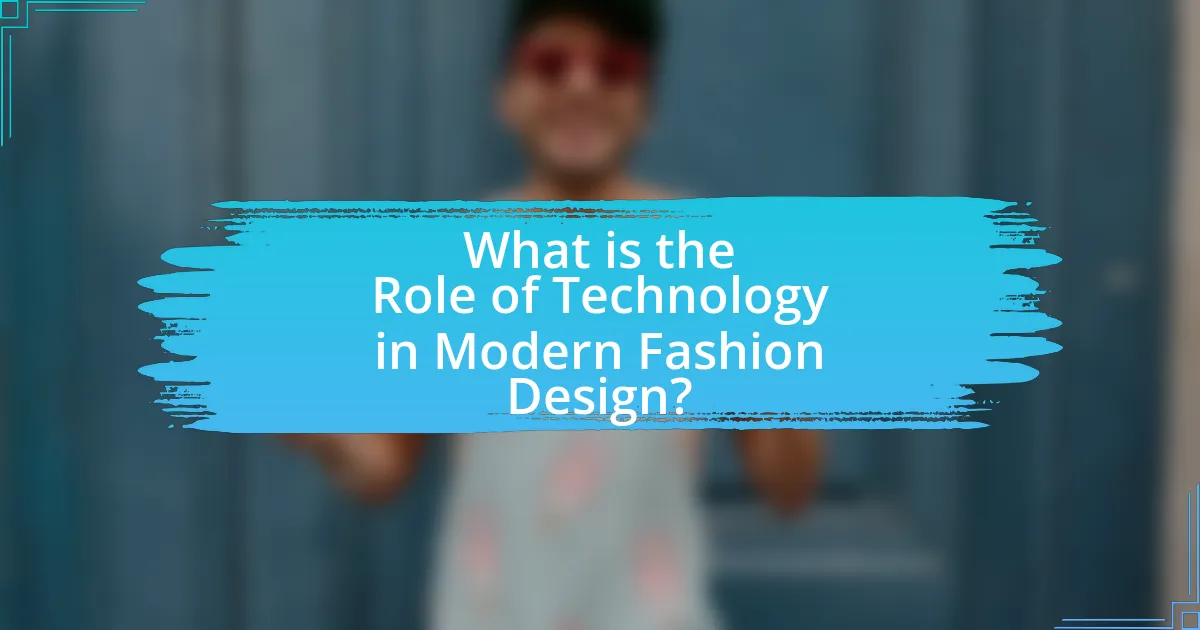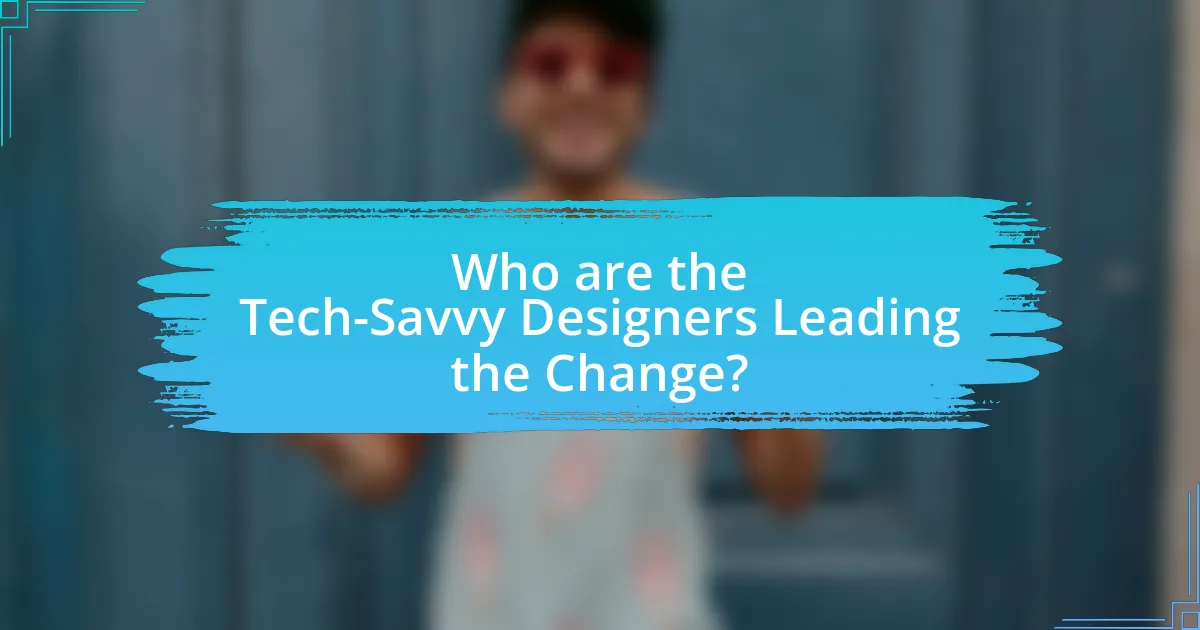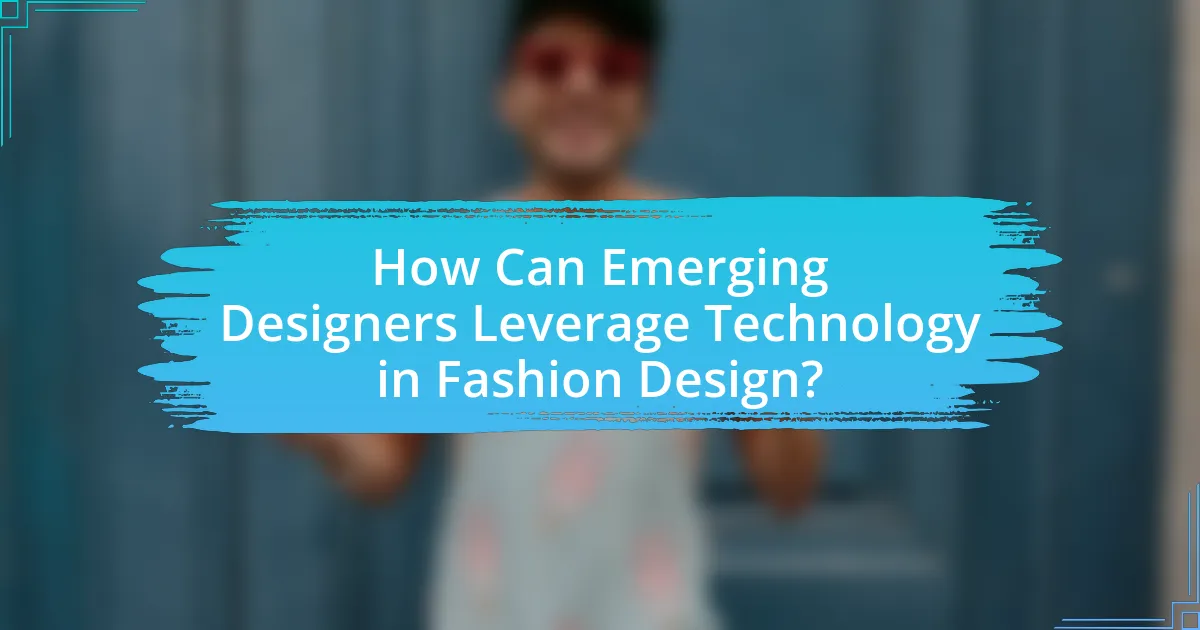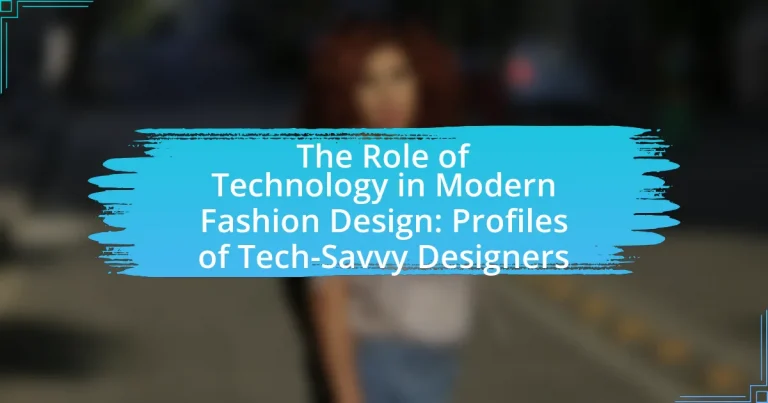The article examines the significant role of technology in modern fashion design, highlighting how advancements such as 3D printing, artificial intelligence, and sustainable materials enhance creativity, efficiency, and sustainability within the industry. It discusses the transformation of the design process through tools like CAD software and digital printing, which streamline workflows and reduce waste. Additionally, the article profiles notable tech-savvy designers, such as Iris van Herpen and Hussein Chalayan, who exemplify the integration of technology in their work. It also addresses the challenges designers face without technology and offers insights into best practices for emerging designers to leverage these tools effectively.

What is the Role of Technology in Modern Fashion Design?
Technology plays a crucial role in modern fashion design by enhancing creativity, efficiency, and sustainability. Designers utilize advanced software for 3D modeling and virtual prototyping, allowing for rapid iterations and reduced waste in the design process. For instance, tools like Adobe Illustrator and CLO 3D enable designers to visualize garments before production, streamlining the workflow. Additionally, technology facilitates the use of sustainable materials and production methods, such as digital printing and automated cutting machines, which minimize environmental impact. According to a report by McKinsey & Company, the integration of technology in fashion can lead to a 30% reduction in production costs and a significant decrease in lead times, demonstrating its transformative effect on the industry.
How has technology transformed the fashion design process?
Technology has significantly transformed the fashion design process by integrating advanced tools and software that enhance creativity and efficiency. Designers now utilize computer-aided design (CAD) software, which allows for precise garment visualization and modification, streamlining the prototyping phase. Additionally, 3D printing technology enables the rapid production of samples, reducing time and material waste. According to a report by McKinsey & Company, the adoption of digital tools in fashion can lead to a 30% reduction in design time. Furthermore, data analytics and artificial intelligence are increasingly used to predict trends and consumer preferences, allowing designers to create more targeted collections. This technological evolution not only accelerates the design process but also fosters innovation and sustainability within the industry.
What are the key technological advancements influencing fashion design?
Key technological advancements influencing fashion design include 3D printing, artificial intelligence, and sustainable materials. 3D printing allows designers to create intricate patterns and prototypes rapidly, reducing waste and enabling customization. Artificial intelligence enhances design processes through predictive analytics, trend forecasting, and personalized shopping experiences, as seen in platforms like Stitch Fix. Sustainable materials, such as bio-fabricated textiles and recycled fibers, are increasingly adopted to address environmental concerns, with brands like Stella McCartney leading the way in eco-friendly fashion. These advancements collectively reshape the fashion industry by improving efficiency, personalization, and sustainability.
How do these advancements enhance creativity and efficiency?
Advancements in technology enhance creativity and efficiency in fashion design by providing designers with innovative tools and platforms that streamline the design process and expand creative possibilities. For instance, 3D modeling software allows designers to visualize and manipulate garments in a virtual space, reducing the time spent on physical prototypes and enabling rapid iteration of ideas. Additionally, digital fabric printing technology enables intricate designs to be produced directly onto fabrics, which fosters unique artistic expression while minimizing waste. According to a study by the Fashion Institute of Technology, the integration of technology in design processes has led to a 30% increase in productivity among designers, demonstrating a clear link between technological advancements and enhanced efficiency in the fashion industry.
Why is technology essential for contemporary fashion designers?
Technology is essential for contemporary fashion designers because it enhances creativity, efficiency, and market reach. Designers utilize advanced software for pattern making, 3D modeling, and virtual fitting, which streamlines the design process and reduces material waste. For instance, tools like Adobe Illustrator and CLO 3D allow designers to visualize their concepts in real-time, facilitating quicker iterations and more innovative designs. Additionally, technology enables designers to leverage e-commerce platforms and social media for broader audience engagement, significantly increasing their market presence. According to a report by McKinsey & Company, the integration of technology in fashion can lead to a 30% reduction in time-to-market, underscoring its critical role in modern design practices.
What challenges do designers face without technology?
Designers face significant challenges without technology, including limited design capabilities, inefficient communication, and slower production processes. The absence of advanced design software restricts their ability to create intricate patterns and visualize concepts, leading to less innovative outcomes. Furthermore, without digital communication tools, collaboration with teams and clients becomes cumbersome, resulting in misunderstandings and delays. Production timelines are also adversely affected, as manual methods are time-consuming and prone to errors, ultimately hindering the designer’s ability to meet market demands efficiently. These challenges underscore the critical role technology plays in enhancing creativity and operational efficiency in modern fashion design.
How does technology facilitate collaboration in fashion design?
Technology facilitates collaboration in fashion design by enabling real-time communication and sharing of resources among designers, manufacturers, and stakeholders. Tools such as cloud-based platforms allow multiple users to access and edit design files simultaneously, streamlining the creative process. For instance, software like Adobe Creative Cloud and collaborative tools like Slack enhance teamwork by providing instant feedback and facilitating discussions regardless of geographical barriers. Additionally, technologies such as 3D modeling and virtual reality enable designers to visualize and present their concepts more effectively, fostering a more interactive and engaging collaborative environment. These advancements have been shown to reduce production timelines and improve overall project outcomes in the fashion industry.

Who are the Tech-Savvy Designers Leading the Change?
Tech-savvy designers leading the change in modern fashion include Iris van Herpen, known for her innovative use of 3D printing, and Hussein Chalayan, who integrates technology with fashion through smart textiles. Iris van Herpen’s designs have revolutionized the industry by merging traditional craftsmanship with cutting-edge technology, exemplified by her 3D-printed garments showcased at Paris Fashion Week. Hussein Chalayan has pushed boundaries by creating garments that respond to environmental stimuli, such as his “Airborne” collection, which featured dresses that transformed shape through mechanical means. These designers exemplify the intersection of technology and fashion, driving forward the evolution of design practices.
What characteristics define tech-savvy fashion designers?
Tech-savvy fashion designers are characterized by their proficiency in digital tools, innovative use of technology, and adaptability to new trends. These designers leverage software for design, such as CAD (Computer-Aided Design), to create intricate patterns and prototypes efficiently. They also utilize social media and e-commerce platforms to market their collections and engage with consumers directly, reflecting a shift in how fashion is presented and sold. Furthermore, tech-savvy designers often incorporate sustainable practices through technology, such as 3D printing and smart textiles, which enhance both creativity and environmental responsibility. This integration of technology not only streamlines the design process but also aligns with contemporary consumer demands for transparency and sustainability in fashion.
How do these designers integrate technology into their work?
Designers integrate technology into their work by utilizing advanced software for design visualization, 3D modeling, and digital pattern making. For instance, tools like Adobe Illustrator and CAD software enable designers to create precise digital sketches and patterns, streamlining the design process. Additionally, some designers employ virtual reality (VR) and augmented reality (AR) to enhance customer experiences, allowing clients to visualize garments in a virtual space before production. The use of wearable technology, such as smart fabrics that monitor health metrics, further exemplifies how designers are merging fashion with technological innovation. This integration not only improves efficiency but also fosters creativity and personalization in fashion design.
What skills are essential for designers to thrive in a tech-driven environment?
Designers must possess a combination of technical proficiency, creativity, and adaptability to thrive in a tech-driven environment. Technical proficiency includes skills in software such as Adobe Creative Suite, 3D modeling tools, and an understanding of coding languages, which are essential for creating innovative designs and prototypes. Creativity allows designers to conceptualize unique ideas that leverage technology, while adaptability ensures they can keep pace with rapid technological advancements and changing market demands. According to a report by the Council of Fashion Designers of America, 85% of fashion companies now prioritize digital skills in their hiring processes, highlighting the importance of these competencies in the industry.
Which notable designers are recognized for their technological innovations?
Notable designers recognized for their technological innovations include Iris van Herpen, known for her use of 3D printing in fashion, and Hussein Chalayan, who integrates technology into wearable art. Iris van Herpen’s collections often feature intricate designs created through advanced digital fabrication techniques, showcasing the intersection of fashion and technology. Hussein Chalayan has pioneered the use of electronics in clothing, exemplified by his designs that incorporate kinetic elements and transformation. These designers exemplify how technology can redefine fashion aesthetics and functionality.
What specific technologies have these designers adopted?
Tech-savvy designers have adopted technologies such as 3D printing, augmented reality (AR), and artificial intelligence (AI) in their fashion design processes. For instance, 3D printing allows for rapid prototyping and customization of garments, enabling designers to create intricate designs that were previously impossible. Augmented reality enhances the shopping experience by allowing customers to visualize clothing on themselves before purchase. Additionally, artificial intelligence is utilized for trend forecasting and personalized recommendations, streamlining the design process and improving customer engagement. These technologies are reshaping the fashion industry by increasing efficiency and enhancing creativity.
How have their innovations impacted the fashion industry?
Innovations by tech-savvy designers have significantly transformed the fashion industry by integrating advanced technologies such as 3D printing, artificial intelligence, and sustainable materials. For instance, 3D printing allows for rapid prototyping and customization, enabling designers to create intricate designs that were previously impossible, thus reducing waste and production time. Additionally, the use of artificial intelligence in trend forecasting and inventory management has optimized supply chains, leading to more efficient production processes. A notable example is the collaboration between fashion brands and tech companies, which has resulted in the development of smart textiles that enhance functionality while maintaining aesthetic appeal. These innovations not only improve operational efficiency but also cater to the growing consumer demand for personalized and sustainable fashion options.

How Can Emerging Designers Leverage Technology in Fashion Design?
Emerging designers can leverage technology in fashion design by utilizing digital tools for design, production, and marketing. For instance, software like Adobe Illustrator and CAD programs enable designers to create precise digital sketches and patterns, streamlining the design process. Additionally, 3D printing technology allows for rapid prototyping, enabling designers to create samples quickly and efficiently, reducing time and costs associated with traditional methods. Furthermore, social media platforms and e-commerce websites provide emerging designers with direct access to consumers, facilitating brand building and market reach without the need for traditional retail channels. According to a report by McKinsey & Company, the integration of technology in fashion can lead to a 30% reduction in time-to-market, demonstrating the tangible benefits of adopting these tools.
What tools and software should emerging designers consider using?
Emerging designers should consider using tools and software such as Adobe Creative Suite (including Photoshop and Illustrator), Sketch, Figma, and CLO 3D. Adobe Creative Suite is widely recognized in the fashion industry for graphic design and illustration, enabling designers to create high-quality visuals and technical sketches. Sketch and Figma are essential for user interface and experience design, allowing for collaborative work and prototyping. CLO 3D specializes in 3D garment visualization, which helps designers simulate how fabrics will behave in real life, enhancing the design process. These tools are integral to modern fashion design, as they streamline workflows and improve creativity and efficiency.
How can these tools improve design accuracy and presentation?
These tools can improve design accuracy and presentation by enabling precise measurements and real-time visualization. Advanced software allows designers to create detailed 3D models, ensuring that proportions and dimensions are accurate before production. For instance, tools like CAD (Computer-Aided Design) software facilitate intricate detailing and adjustments, reducing the likelihood of errors that can occur in manual drafting. Additionally, technologies such as virtual reality (VR) and augmented reality (AR) provide immersive experiences, allowing designers and clients to visualize garments in a realistic context, enhancing the overall presentation. This integration of technology not only streamlines the design process but also elevates the quality of the final product, as evidenced by the increased adoption of these tools in the fashion industry, leading to higher customer satisfaction and reduced returns.
What resources are available for learning about fashion technology?
Resources available for learning about fashion technology include online courses, industry publications, and academic programs. Online platforms like Coursera and Udemy offer courses specifically focused on fashion technology, covering topics such as digital design and textile innovation. Industry publications like “WGSN” and “Business of Fashion” provide insights into current trends and technological advancements in fashion. Additionally, universities such as the Fashion Institute of Technology and Central Saint Martins offer degree programs that integrate technology into fashion design, equipping students with the necessary skills and knowledge to thrive in the tech-driven fashion industry.
What best practices should designers follow when incorporating technology?
Designers should prioritize user-centered design principles when incorporating technology. This involves understanding the needs and preferences of the target audience to create functional and appealing products. For instance, integrating wearable technology requires designers to consider comfort, usability, and aesthetics, ensuring that the technology enhances the user experience rather than detracts from it. Research indicates that products designed with user feedback lead to higher satisfaction rates, as seen in the success of smart textiles that blend fashion with functionality. Additionally, staying updated with technological advancements and collaborating with tech experts can foster innovation, as demonstrated by designers who successfully merge fashion with augmented reality to create immersive shopping experiences.
How can designers balance creativity with technological constraints?
Designers can balance creativity with technological constraints by leveraging technology as a tool for innovation rather than a limitation. For instance, using advanced software for 3D modeling allows designers to visualize and iterate their ideas quickly, enabling creative exploration within the bounds of production capabilities. Additionally, designers can adopt a mindset that embraces constraints as opportunities for unique solutions, as seen in the work of designers like Iris van Herpen, who integrates digital fabrication techniques to create intricate designs that push the boundaries of traditional fashion. This approach not only fosters creativity but also aligns with the practical aspects of manufacturing, ensuring that innovative designs are feasible and market-ready.
What common pitfalls should designers avoid when using technology?
Designers should avoid over-reliance on technology, which can lead to a lack of creativity and originality in their work. When designers depend too heavily on software tools for design, they may produce generic results that lack personal touch and innovation. Additionally, neglecting user experience by focusing solely on aesthetics can result in designs that are visually appealing but impractical. Research indicates that 70% of users abandon websites due to poor usability, highlighting the importance of balancing technology with user-centered design principles. Lastly, failing to stay updated with technological advancements can leave designers behind in a rapidly evolving industry, as new tools and techniques can significantly enhance design processes and outcomes.

















